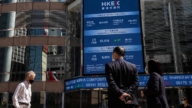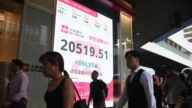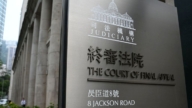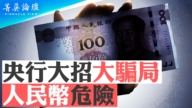【新唐人2011年6月25日讯】美国《华尔街日报》日前指出,中国国家债务接近于国内生产总值GDP的80%,这还不包括地方政府债务,也不包括刺激经济贷款中提供给国有企业的其余70%。中国海内外专家指出,政府债务绑架中国经济,政府靠加印钞票解决债务及不良贷款,造成通货膨胀和房地产泡沫,最终由老百姓买单。
《华尔街日报》6月21号的这篇文章指出,2009年刺激经济计划产生的第一批不良贷款,即将冲击中国的银行系统。中共当局目前正在考虑为2到3万亿元人民币左右的不良贷款承担责任。
文章还说,这次救助计划的规模,几乎相当于本世纪初中国重组四大国有银行时剥离的坏账总额。具有讽刺意味的是,这项救助还大体相当于中国2008年4万亿元经济刺激方案的规模。
《华尔街日报》的这篇文章刺激了北京当局的神经。《新华社》23号发表文章,引述财政部财政科学研究所副所长白景明的话反驳说:“这显然高估了中国的债务规模和潜在风险。”
而总部设在香港的研究机构GaveKal Asia近日发布的报告指出,中国公共债务占GDP的比重在过去十年间,基本稳定在80%左右﹔中国目前的公共债务已达到2010年GDP的90%水平。
报告还说,中国地方政府债务占GDP的比例已经超过了美国和巴西。不过,报告认为,“封闭的金融系统”,使中国几乎不可能发生像希腊政府那样的债务危机。
北京天则经济研究所理事长茅于轼:“中国的情况很特别,中国银行不会倒闭的,因为政府做后台。因此它对付倒闭这个问题怎么办呢?那就是印钞票。银行倒闭是什么意思呢?就是存进来的钱少,取出去的钱多,它没有钱了,那时候怎么办呢?那时候就印钞票。”
根据北京央行数据,到去年9月底超发货币将近43万亿元。《华尔街日报》6月23号的文章指出,在不太可能发生债务危机的情况下,长期以来承受重压的中国家庭,将以某种形式为政府大多数债务买单。
经济学家谢国忠表示,农副产品轮番上涨其实都是央行货币超发的结果,多余的钱在市场中乱窜,多年累计起来的过量货币,给中国经济实体带来了巨大的通胀风险。
而财经评论家草庵居士说:“因为中共大量的国债,它通货膨胀的时候变相的把这个债务稀释了,所以政府它想要保持一个通货膨胀的速度。所以这就是变相的去掠夺百姓。”
《路透社》6月1号独家援引消息人士披露,中国银监会、财政部及发改委,计划在6月到9月,清理可能违约的地方政府债务及银行坏帐2到3万亿人民币。
而中国“三星经济研究院”预测,到今年年底,地方政府债务总额将达到12.5万亿元左右,接近去年中国GDP的的三分之一。同时,大量地方债在今年(2011年)到2013年期间,将进入还款期,中国债务风险会在未来两三年集中爆发。
茅于轼:“最后的结局就是印钞票,在中国的情况;像美国的情况就是银行倒闭,中国的情况银行不会倒闭的。什么问题也没有就能把坏帐问题对付过去,那是不可能的。坏帐的最后承担者是谁?没有别人,就是老百姓。”
另外,《华尔街日报》发表中国证券业协会李迅雷副主委的文章说,加息是让目前资产泡沫消退的最有力手段,但房地产泡沫一旦破灭,就意味着地方政府的土地财政难以为继,这会导致债务链的断裂,最终导致银行坏账率大幅上升乃至金融危机。他认为,地方政府债务问题绑架了中国经济。
而《国际财经时报》22号的文章指出,近期一些经济学家分析担心,即便中国经济实现“软着陆”,累积如山的地方政府债务,可能导致中国经济在今后多年增长乏力。
新唐人记者常春、李元翰、萧宇采访报导。
Government Debts Undermine Economy, Who Will Pay the Bill?
WSJ reported lately, China’s national debt to GDP ratio
reached 80%. This doesn’t include local governments’
debts and the loans provided to stimulate economy.
Experts said, national debts burdened China’s economy.
The regime printed money to resolve debts and
non-performing loans, resulting in inflation.
Eventually, Chinese people will end up paying the bill.
The WSJ article published on June 21 said, the 1st batch
of non-performing loans provided in 2009 will soon
impact China’s banking system. The CCP authorities
are now considering who should be responsible for
the RMB 2 to 3 trillion yuan non-performing loans.
It also said, the scale of 2009 stimulation almost equals
to that of the reorganization of 4 top China banks.
Ironically, it’s also similar to that of the 4 trillion
economy stimulation plan in 2008.
The article obviously irritated Beijing. On June 23,
Xinhua News Agency quoted finance ministry’s
expert Bai Jingming’s refute, saying it overestimated
China’s debts scale and potential risks.
While recent reports from GaveKal Asia, a HK based
research institute, said, China’s national debt-to-GDP
ratio leveled around 80% in the past 19 year.
But in 2010, the ratio rose to 90%.
The report also said that Chinese local governments’
debts to GDP ratio has been higher than that of the U.S.
and Brazil. However, the report believes that China’s
‘closed financial system’ will not bring China into
the financial crisis like in Greece.
Mao Yushi, a famous Chinese economist: “China has
a unique situation. Chinese banks will not go bankrupt
because the governments are backing them up.
Then, how do they handle the issue of bankruptcy?
By printing currency. What does it mean by a bank
going bankrupt? It is when less money coming in than
going out. What can it do then? Printing the money.
China Central Bank’s statistics show that by Sep. 2010,
additional RMB43,000 billion yuan is in circulation.
A June 23 WSJ article said, Chinese families are under
heavy burdens of unknowingly paying for the debts of
the regime not in the case of an economic crisis.
Economist Xie Guozhong said, the agri-food price hike
is the consequence of Central Bank’s issuance of
excessive currency. The excessive liquidity accumulated
over the years is freely moving around the market,
rendering Chinese economy rather vulnerable to inflation.
Caoan Jushi (financial commentator): “The CCP has
a huge amount of national debts, but inflation indirectly
dilutes its debts. This is why the CCP wants to maintain
a certain inflation rate, which is equal to rob the citizens."
On June 1, Reuters reported China Banking Regulatory
Commission, Ministry of Finance and Development and
Reform Commission plan to clean up local government
debts and bad loans between June and Sept.
totaling about 200-300 million yuan.
According to a forecast by Samsung Economic Research
Institute in China, by the end of this year, debts of
local governments will reach 12.5 trillion yuan,
almost one-third of China’s GDP last year. Meanwhile,
a large portion will enter the repayment period
between 2011 and 2013. China’s debt crisis can
break out in two or three years.
Mao Yushi: “The final outcome is printing money,
that is what will happen in China; If it is in the U.S.
there’ll be bank failures, but China won’t have bank failures
It’s impossible that the bad loan problem will disappear
as if nothing has ever happened. Who will pay for
these bad loans? Nobody, but the Chinese citizens.
WSJ also carried an article by Li Xunlei, assoc. director,
Securities Assoc. of China, saying interest hike is
the best way to control the real estate bubble.
Once the bubble is burst, the local governments
will have difficulty renewing their revenues,
causing the debt chain to break and non-performing
loans to increase, or even financial crisis to occur.
He believes the local governments’ debts
have undermined Chinese economy.
International Financial Times reported on June 22,
some economists worry that even if China’s economy
takes soft landing, the mounting debts of the local
governments will cripple Chinese economy for years.
NTD reporters Chang Chun, Li Yuanhan and Xiao Yu.





























